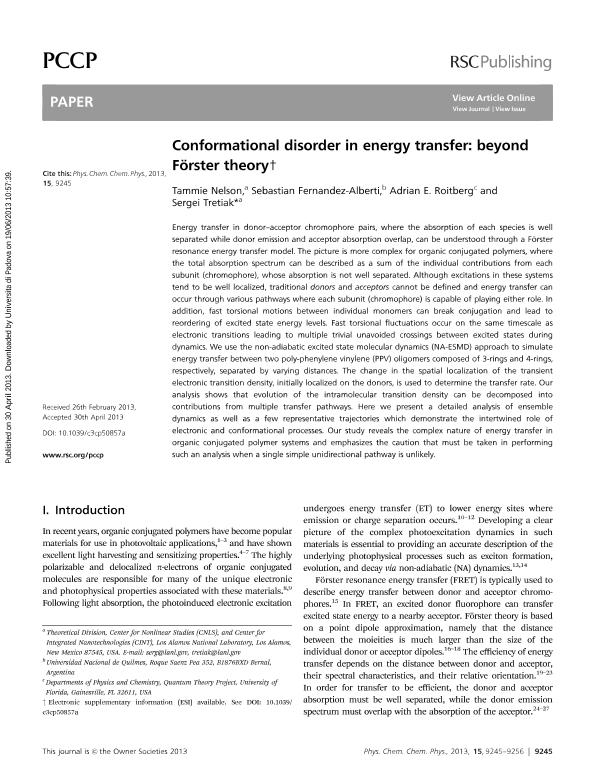Mostrar el registro sencillo del ítem
dc.contributor.author
Nelson, Tammie
dc.contributor.author
Fernández Alberti, Sebastián

dc.contributor.author
Roitberg, Adrián

dc.contributor.author
Tretiak, Sergei
dc.date.available
2017-09-13T20:57:57Z
dc.date.issued
2013-04
dc.identifier.citation
Nelson, Tammie; Fernández Alberti, Sebastián; Roitberg, Adrián; Tretiak, Sergei; Conformational disorder in energy transfer: beyond Förster theory; Royal Society of Chemistry; Physical Chemistry Chemical Physics; 23; 15; 4-2013; 9245-9256
dc.identifier.issn
1463-9076
dc.identifier.uri
http://hdl.handle.net/11336/24213
dc.description.abstract
Energy transfer in donor–acceptor chromophore pairs, where the absorption of each species is well separated while donor emission and acceptor absorption overlap, can be understood through a Förster resonance energy transfer model. The picture is more complex for organic conjugated polymers, where the total absorption spectrum can be described as a sum of the individual contributions from each subunit (chromophore), whose absorption is not well separated. Although excitations in these systems tend to be well localized, traditional donors and acceptors cannot be defined and energy transfer can occur through various pathways where each subunit (chromophore) is capable of playing either role. In addition, fast torsional motions between individual monomers can break conjugation and lead to reordering of excited state energy levels. Fast torsional fluctuations occur on the same timescale as electronic transitions leading to multiple trivial unavoided crossings between excited states during dynamics. We use the non-adiabatic excited state molecular dynamics (NA-ESMD) approach to simulate energy transfer between two poly-phenylene vinylene (PPV) oligomers composed of 3-rings and 4-rings, respectively, separated by varying distances. The change in the spatial localization of the transient electronic transition density, initially localized on the donors, is used to determine the transfer rate. Our analysis shows that evolution of the intramolecular transition density can be decomposed into contributions from multiple transfer pathways. Here we present a detailed analysis of ensemble dynamics as well as a few representative trajectories which demonstrate the intertwined role of electronic and conformational processes. Our study reveals the complex nature of energy transfer in organic conjugated polymer systems and emphasizes the caution that must be taken in performing such an analysis when a single simple unidirectional pathway is unlikely.
dc.format
application/pdf
dc.language.iso
eng
dc.publisher
Royal Society of Chemistry

dc.rights
info:eu-repo/semantics/openAccess
dc.rights.uri
https://creativecommons.org/licenses/by-nc-sa/2.5/ar/
dc.subject
Forster
dc.subject
Energy
dc.subject.classification
Otras Ciencias Químicas

dc.subject.classification
Ciencias Químicas

dc.subject.classification
CIENCIAS NATURALES Y EXACTAS

dc.title
Conformational disorder in energy transfer: beyond Förster theory
dc.type
info:eu-repo/semantics/article
dc.type
info:ar-repo/semantics/artículo
dc.type
info:eu-repo/semantics/publishedVersion
dc.date.updated
2017-09-12T16:31:35Z
dc.journal.volume
23
dc.journal.number
15
dc.journal.pagination
9245-9256
dc.journal.pais
Reino Unido

dc.journal.ciudad
Cambridge
dc.description.fil
Fil: Nelson, Tammie. Los Alamos National Laboratory; Estados Unidos
dc.description.fil
Fil: Fernández Alberti, Sebastián. Universidad Nacional de Quilmes; Argentina. Consejo Nacional de Investigaciones Científicas y Técnicas; Argentina
dc.description.fil
Fil: Roitberg, Adrián. University of Florida; Estados Unidos
dc.description.fil
Fil: Tretiak, Sergei. Los Alamos National Laboratory; Estados Unidos
dc.journal.title
Physical Chemistry Chemical Physics

dc.relation.alternativeid
info:eu-repo/semantics/altIdentifier/doi/http://dx.doi.org/10.1039/c3cp50857a
dc.relation.alternativeid
info:eu-repo/semantics/altIdentifier/url/http://pubs.rsc.org/en/Content/ArticleLanding/2013/CP/c3cp50857a#!divAbstract
Archivos asociados
